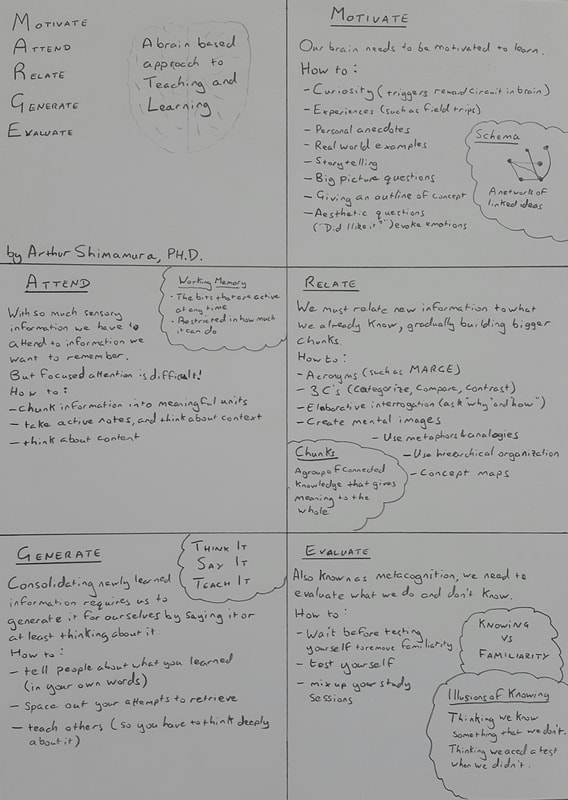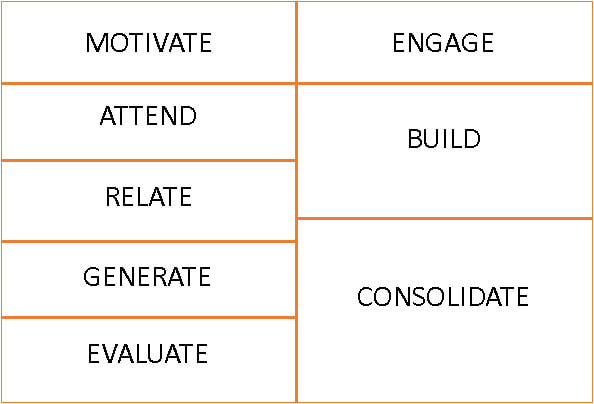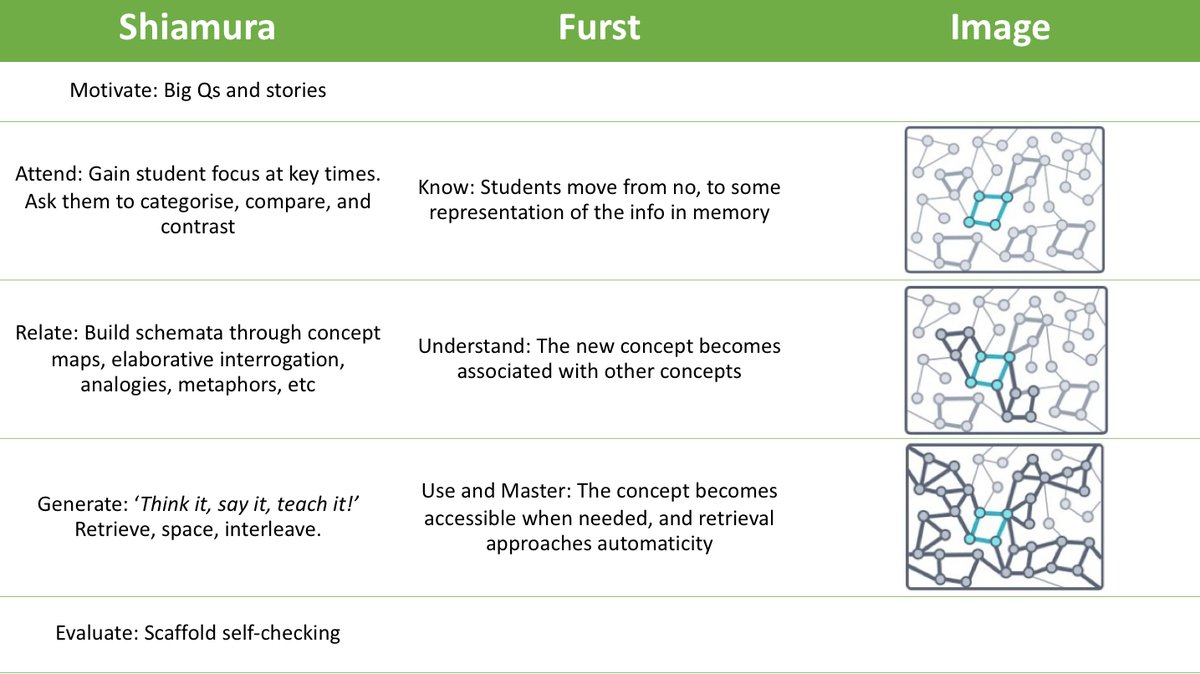- The Science of Learning through FutureLearn
- Learning How To Learn through Coursera
MARGE is the acronym used by Shimamura to stand for Motivate, Attend, Relate, Generate, Evaluate. In the ebook, Shimamura gives both an overview of this model and goes into detail for each of the aspects. He also discusses the brain functions behind each of these.
EBC stands for Engage, Build, Consolidate, and this was the model offered for the process of learning in The Science of Learning course through FutureLearn. The course goes into detail about each of these three stages, and the brain functions behind them, as well as looking at other areas of learning.
When I read MARGE I immediately saw some connections to the EBC framework I had previously seen, and as one of the techniques recommended was the 3 C's (Categorise, Compare and Contrast) to help develop schema, I thought I would do just that.
The ENGAGE/MOTIVATE section of learning was made very clear in both the MARGE document and the Science of Learning course. Without engaging the brain to learn, everything we do after that is not going to be as effective as it could be.
Before starting a lesson or new topic, we should do something to ENGAGE the brain or MOTIVATE the learning. There are many options for this, including:
- A starter question from a previous topic that will ENGAGE the brain to be ready for the new content (this has links to RELATE and BUILD);
- A question that sparks curiosity in the students and a MOTIVATION to learn to answer the question;
- An anecdote or story narrative which can create MOTIVATION by causing students to question ("What will happen next?");
- Give an outline of the big picture of a topic before diving into the details, to develop a sense of questioning around the specifics.
The start of the BUILD section of learning is that we have to focus on what we want to learn. That is, we have to ATTEND to the information that we want to BUILD into our existing schema of knowledge. This is achieved by the Prefrontal Cortex (the bit of the brain at the front) which acts a bit like a conductor to the orchestra that is your brain, directing which bits of the brain need to be active to ATTEND to the given stimulus.
- Using acronyms (such as MARGE)
- Creating visual imagery
- Using the 3C's (categorise, compare and contrast, which is what I am attempting to do in this post)
- Make use of elaborative-interrogation (asking yourself "how" and "why" questions when studying)
- Using metaphors and analogies to RELATE new ideas to old ones
- Using conceptual hierarchies (to create an inbuilt schema for the information)
We need to help create environments where students can ATTEND to new information and RELATE it to prior knowledge in order to BUILD new knowledge. We can do this by:
- Keeping the limited working memory of our students in mind, and removing unnecessary distractions (see Cognitive Load Theory for more on this);
- Focus students ATTENTION on the information that you want them to learn by insisting on silence when introducing new content;
- Get students thinking about the content as soon as possible;
- Help students to CHUNK ideas, by building meaningful models for them;
- Get students to RELATE new content to things they already know (and make this explicit for them)
- Have students use the 3C's, analogies, metaphors, concept maps, etc to help RELATE new information to prior knowledge
The process of CONSOLIDATION is about making material that we have seen long lasting AND more easily transferable. Physiologically, what happens is that the areas that are activated when we think about consolidated knowledge as opposed to new knowledge is that the active areas are further back in the brain. This "frees up" working memory in the prefrontal cortex to focus on other aspects of a problem or on learning even more new knowledge.
- We are unable to consolidate the new things we have learned during the day;
- We are not in the best state to learn new things the next day.
We need to provide time for students to CONSOLIDATE their new knowledge into their long-term memory, by giving them plenty of opportunities to GENERATE the material and RELATE it to other things they know. We can do this by:
- Giving students opportunities to teach others about what they have learned;
- Using quizzes as learning tools;
- Using interactive tools such as Kahoot and Quizlet to engage students in retrieving;
- Have students use the 3C's and other techniques, but from GENERATED material.
- Using questions to identify missing knowledge;
- Leaving time between GENERATING material;
- Mixing up their study of different topics.
The EBC model is all about the general processes involved in learning new material whereas MARGE is about the specific things we as teachers (and our students) should be doing to improve learning. The overlap is that the aspects of MARGE help us do each of the principles from EBC.
I actually think both models have a lot to offer to help teachers (and students) to understand the processes we go through to learn new things. Both in terms of the biological functions (what happens where in the brain) and the implications on what we should do. EBC offers an overriding set of principles that we need to consider when planning out long term units: how will we ENGAGE students in the learning; how will we BUILD the new knowledge; how will we CONSOLIDATE this in long term memory? And MARGE gives us some advice on how to achieve these things successfully; MOTIVATE through curiosity and questions; make sure students ATTEND to the new information we want them to learn; have students RELATE the new knowledge to what they already know; provide as many opportunities as possible for students to GENERATE the knowledge in their own words; and help students EVALUATE their own learning so they can avoid illusions of knowing and fix any gaps in their knowledge.
Ollie Lovell wrote this short thread about MARGE which is an excellent summary of the main ideas.
Previously, I've shared the short booklet 'MARGE' by Prof Arthur Shiamura. It's a booklet on memory and learning using an acronym for Motivate, Attend, Relate, Generate, Evaluate. I wanted to share some takeaways, as summarised by @teacherhead in https://t.co/cmYtoMHRg0 pic.twitter.com/EHgBgoFnBB
— Oliver Lovell (@ollie_lovell) December 11, 2018



 RSS Feed
RSS Feed
